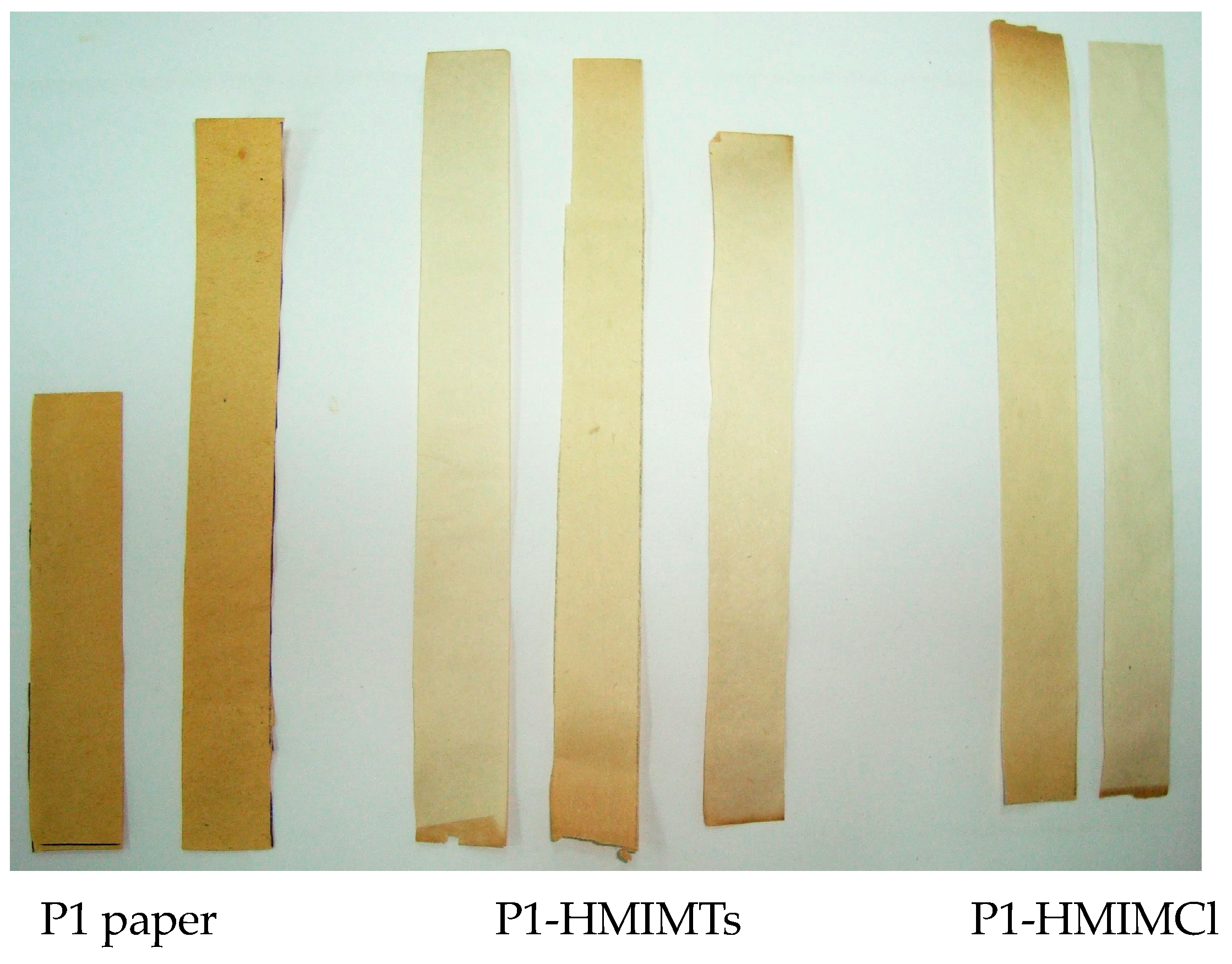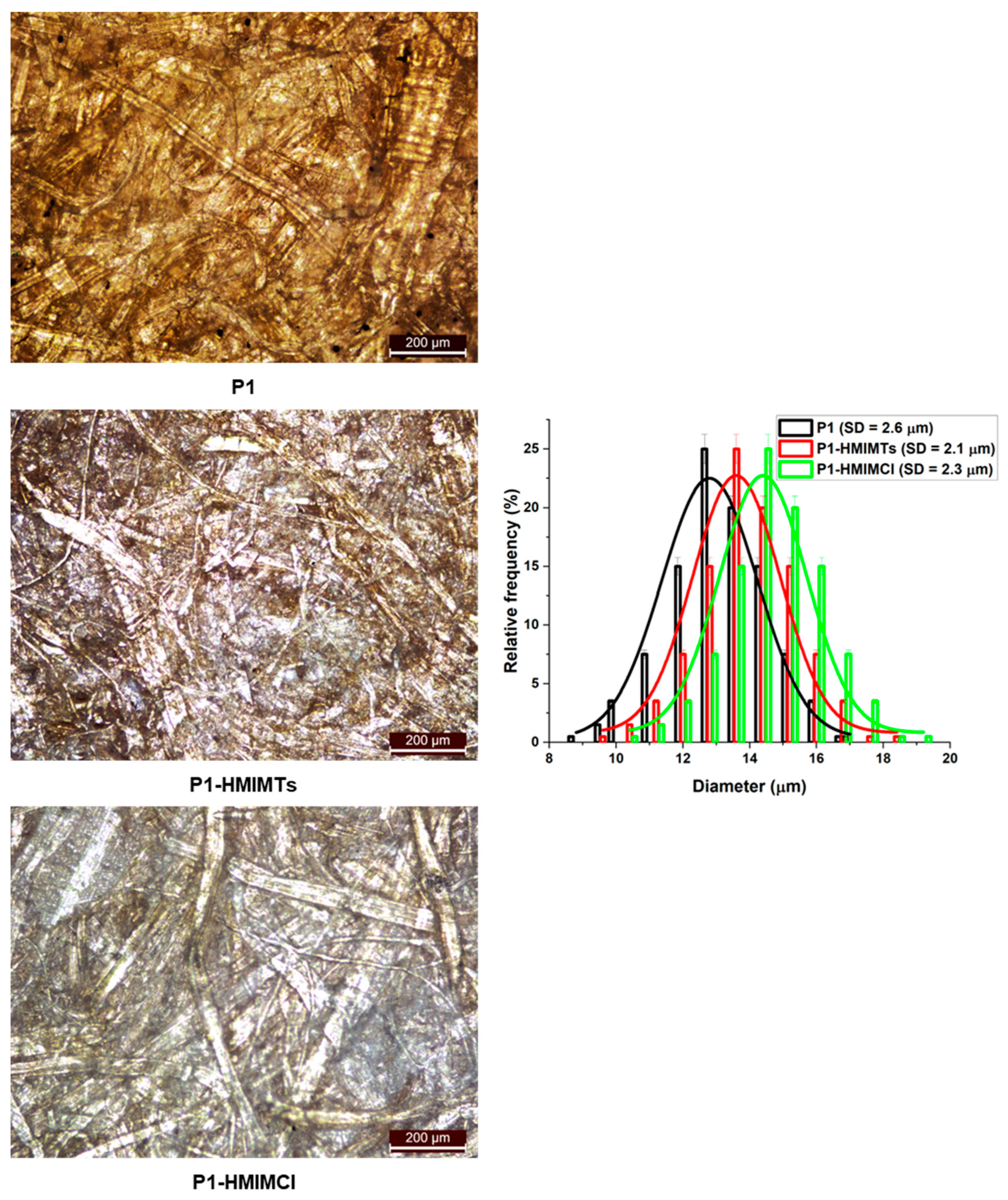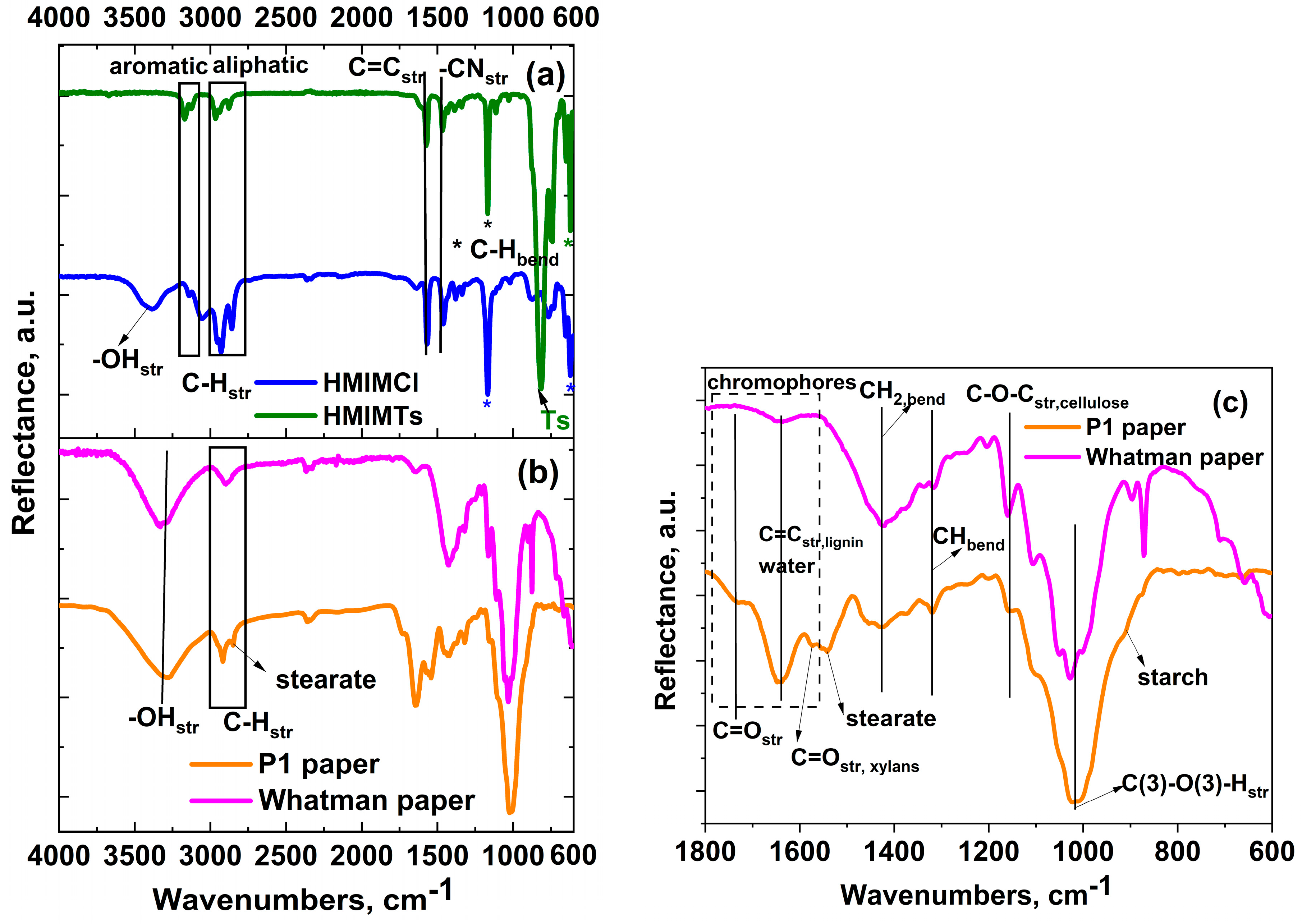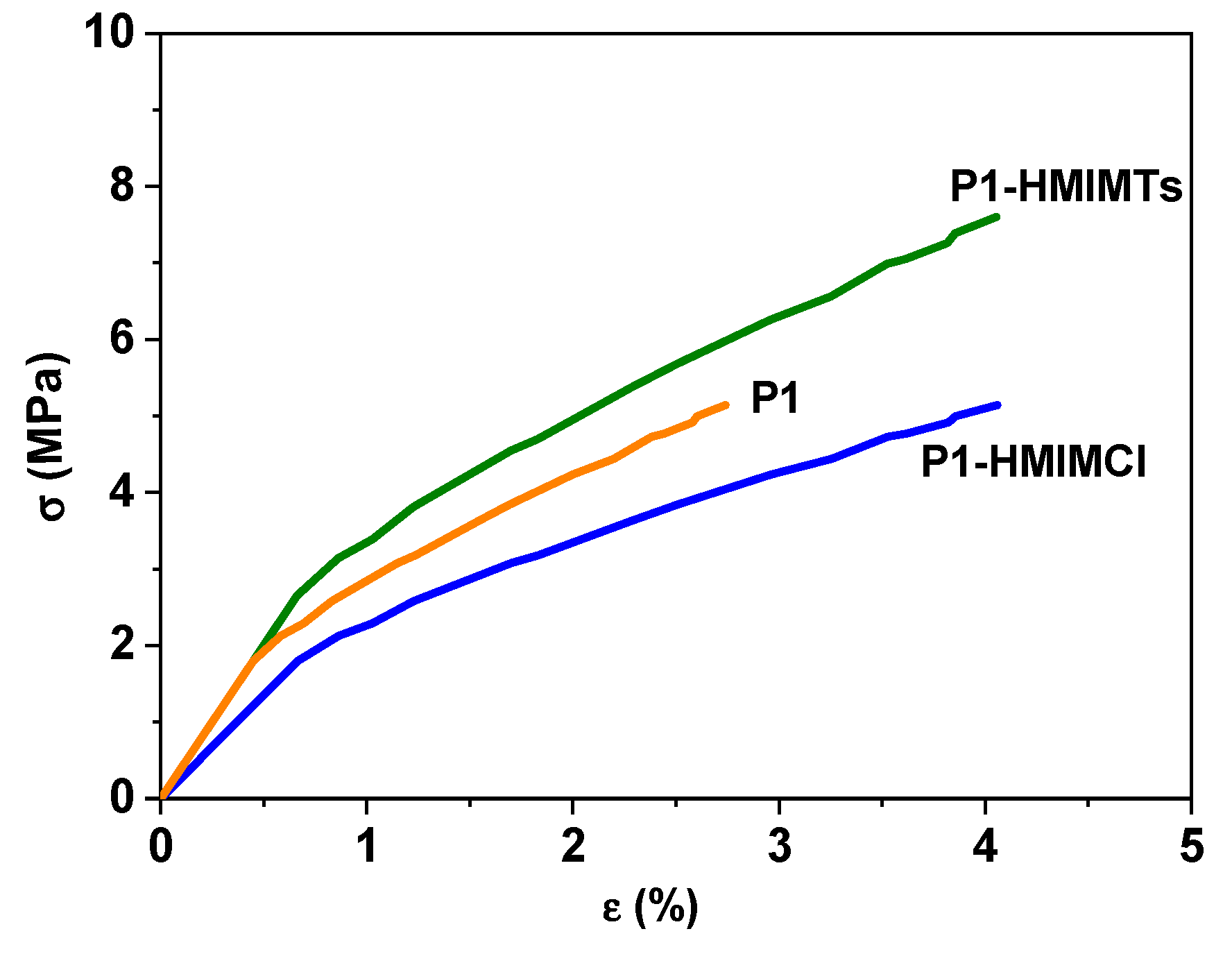Ionic Liquids as Potential Cleaning and Restoration Agents for Cellulosic Artefacts
Abstract
1. Introduction
2. Materials and Methods
3. Results and Discussion
4. Conclusions
Author Contributions
Funding
Data Availability Statement
Conflicts of Interest
References
- Hamburger, S. Preservation and Conservation for Libraries and Archives. Libr. Collect. Acquis. Tech. Serv. 2005, 29, 444–445. [Google Scholar] [CrossRef]
- Lischer-Katz, Z. The Emergence of Digital Reformatting in the History of Preservation Knowledge: 1823–2015. J. Doc. 2022, 78, 1249–1277. [Google Scholar] [CrossRef]
- Verticchio, E.; Frasca, F.; Bertolin, C.; Siani, A.M. Climate-Induced Risk for the Preservation of Paper Collections: Comparative Study among Three Historic Libraries in Italy. Build. Environ. 2021, 206, 108394. [Google Scholar] [CrossRef]
- Rakotonirainy, M.S.; Bénaud, O.; Vilmont, L.B. Contribution to the Characterization of Foxing Stains on Printed Books Using Infrared Spectroscopy and Scanning Electron Microscopy Energy Dispersive Spectrometry. Int. Biodeterior. Biodegrad. 2015, 101, 1–7. [Google Scholar] [CrossRef]
- Tian, W.; Wang, X.; Ye, Y.; Wu, W.; Wang, Y.; Jiang, S.; Wang, J.; Han, X. Recent Progress of Biomass in Conventional Wood Adhesives: A Review. Green Chem. 2023, 25, 10304–10337. [Google Scholar] [CrossRef]
- Marín, E.; Sistach, M.C.; Jiménez, J.; Clemente, M.; Garcia, G.; García, J.F. Distribution of Acidity and Alkalinity on Degraded Manuscripts Containing Iron Gall Ink. Restaurator 2015, 36, 229–247. [Google Scholar] [CrossRef]
- Zotti, M.; Ferroni, A.; Calvini, P. Mycological and FTIR Analysis of Biotic Foxing on Paper Substrates. Int. Biodeterior. Biodegrad. 2011, 65, 569–578. [Google Scholar] [CrossRef]
- ANSI/NISO Z39.48-1992 (R2009). Permanence of Paper for Publications and Documents in Libraries and Archives. NISO: Baltimore, MD, USA, 2010.
- Zervos, S.; Alexopoulou, I. Paper Conservation Methods: A Literature Review. Cellulose 2015, 22, 2859–2897. [Google Scholar] [CrossRef]
- Daniels, V.; Kosek, J. Studies on the Washing of Paper: Part 2: A Comparison of Different Washing Techniques Used on an Artificially Discoloured, Sized Paper. Restaurator 2004, 25, 260–266. [Google Scholar] [CrossRef]
- Corte, A.M.; Ferroni, A.; Salvo, V.S. Isolation of Fungal Species from Test Samples and Maps Damaged by Foxing, and Correlation between These Species and the Environment. Int. Biodeterior. Biodegrad. 2003, 51, 167–173. [Google Scholar] [CrossRef]
- Baty, J.; Maitland, C.L.; Minter, W.; Hubbe, M.A.; Jordan-Mowery, S.K. Deacidification for the conservation and preservation of paper-based works: A review. Bioresources 2010, 5, 1955–2023. [Google Scholar] [CrossRef]
- Niehus, L.; Henniges, U.; Horsky, M.; Prohaska, T.; Potthast, A.; Brückle, I. Reducing the Risks of Hydrogen Peroxide Bleaching in Presence of Iron Ions in Paper. Restaurator 2012, 33, 356–394. [Google Scholar] [CrossRef]
- Parfenov, V.; Galushkin, A.; Tkachenko, T.; Aseev, V. Laser Cleaning as Novel Approach to Preservation of Historical Books and Documents on a Paper Basis. Quantum Beam Sci. 2022, 6, 23. [Google Scholar] [CrossRef]
- Sarantopoulou, E.; Samardzija, Z.; Kobe, S.; Kollia, Z.; Cefalas, A.C. Removing Foxing Stains from Old Paper at 157 Nm. Appl. Surf. Sci. 2003, 208–209, 311–316. [Google Scholar] [CrossRef]
- Ahn, K.; Schedl, A.; Zweckmair, T.; Rosenau, T.; Potthast, A. Fire-induced structural changes and long-term stability of burned historical rag papers. Sci. Rep. 2018, 8. [Google Scholar] [CrossRef]
- Meenatchi, B.; Renuga, V.; Manikandan, A. Cellulose Dissolution and Regeneration Using Various Imidazolium Based Protic Ionic Liquids. J. Mol. Liq. 2017, 238, 582–588. [Google Scholar] [CrossRef]
- El Seoud, O.A.; Kostag, M.; Jedvert, K.; Malek, N.I. Cellulose Regeneration and Chemical Recycling: Closing the “Cellulose Gap” Using Environmentally Benign Solvents. Macromol. Mater. Eng. 2020, 305, 1900832. [Google Scholar] [CrossRef]
- Porto, S.; Shugar, A.N. The Effectiveness of Two Cationic Fixatives in Stabilizing Water-Sensitive Dye-Based Inks on Paper. Book Pap. Group Annu. 2008, 27, 63–69. [Google Scholar]
- Croitoru, C.; Patachia, S.; Lunguleasa, A. New Method of Wood Impregnation with Inorganic Compounds Using Ethyl Methylimidazolium Chloride as Carrier. J. Wood Chem. Technol. 2015, 35, 113–128. [Google Scholar] [CrossRef]
- Croitoru, C.; Patachia, S.; Lunguleasa, A. A Mild Method of Wood Impregnation with Biopolymers and Resins Using 1-Ethyl-3-Methylimidazolium Chloride as Carrier. Chem. Eng. Res. Des. 2015, 93, 257–268. [Google Scholar] [CrossRef]
- Dimitrić, N.; Spremo, N.; Vraneš, M.; Belić, S.; Karaman, M.; Kovačević, S.; Karadžić, M.; Podunavac-Kuzmanović, S.; Korolija-Crkvenjakov, D.; Gadžurić, S. New Protic Ionic Liquids for Fungi and Bacteria Removal from Paper Heritage Artefacts. RSC Adv. 2019, 9, 17905–17912. [Google Scholar] [CrossRef]
- Rajitha, K.; Reddy, G.K.K.; Nancharaiah, Y.V. Assessment of Alkylimidazolium Chloride Ionic Liquid Formulations for Cleaning and Disinfection of Environmental Surfaces. Am. J. Infect. Control 2022, 50, 1032–1037. [Google Scholar] [CrossRef] [PubMed]
- Irizar, P.; Gomez-Laserna, O.; Arana, G.; Madariaga, J.M.; Martínez-Arkarazo, I. Ionic Liquids (ILs)-Loaded Hydrogels as a Potential Cleaning Method of Metallic Stains for Stone Conservation. J. Cult. Herit. 2023, 64, 12–22. [Google Scholar] [CrossRef]
- Croitoru, C.; Patachia, S.; Porzsolt, A.; Friedrich, C. Effect of Alkylimidazolium Based Ionic Liquids on the Structure of UV-Irradiated Cellulose. Cellulose 2011, 18, 1469–1479. [Google Scholar] [CrossRef]
- Geweely, N.S. New Frontiers Review of Some Recent Conservation Techniques of Organic and Inorganic Archaeological Artefacts against Microbial Deterioration. Front. Microbiol. 2023, 14, 1146582. [Google Scholar] [CrossRef] [PubMed]
- Schmitz, K.; Wagner, S.; Reppke, M.; Maier, C.L.; Windeisen-Holzhauser, E.; Philipp Benz, J. Preserving Cultural Heritage: Analyzing the Antifungal Potential of Ionic Liquids Tested in Paper Restoration. PLoS ONE 2019, 14, e0219650. [Google Scholar] [CrossRef]
- Caminiti, R.; Campanella, L.; Plattner, S.H.; Scarpellini, E. Effects of Innovative Green Chemical Treatments on Paper. Can They Help in Preservation? Int. J. Conserv. Sci. 2016, 7, 247–258. [Google Scholar]
- Kozirog, A.; Wysocka-Robak, A. Application of Ionic Liquids in Paper Properties and Preservation. In Progress and Developments in Ionic Liquids; IntechOpen: London, UK, 2017. [Google Scholar]
- Pernak, J.; Jankowska, N.; Walkiewicz, F.; Jankowska, A. The Use of Ionic Liquids in Strategies for Saving and Preserving Cultural Artifacts. Pol. J. Chem. 2008, 82, 2227–2230. [Google Scholar]
- Pacheco, M.F.; Pereira, A.I.; Branco, L.C.; Parola, A.J. Varnish Removal from Paintings Using Ionic Liquids. J. Mater. Chem. A Mater. 2013, 1, 7016. [Google Scholar] [CrossRef]
- Baglioni, M.; Raudino, M.; Berti, D.; Keiderling, U.; Bordes, R.; Holmberg, K.; Baglioni, P. Nanostructured Fluids from Degradable Nonionic Surfactants for the Cleaning of Works of Art from Polymer Contaminants. Soft Matter 2014, 10, 6798. [Google Scholar] [CrossRef]
- T 509 om-02. Hydrogen Ion Concentration (PH) of Paper Extracts (Cold Extraction Method). TAPPI: Atlanta, Georgia, 2002.
- Malešič, J.; Kraševec, I.; Cigić, I.K. Determination of Cellulose Degree of Polymerization in Historical Papers with High Lignin Content. Polymers 2021, 13, 1990. [Google Scholar] [CrossRef]
- Małachowska, E.; Dubowik, M.; Boruszewski, P.; Łojewska, J.; Przybysz, P. Influence of Lignin Content in Cellulose Pulp on Paper Durability. Sci. Rep. 2020, 10, 19998. [Google Scholar] [CrossRef] [PubMed]
- Croitoru, C.; Patachia, S.; Doroftei, F.; Parparita, E.; Vasile, C. Ionic Liquids Influence on the Surface Properties of Electron Beam Irradiated Wood. Appl. Surf. Sci. 2014, 314, 956–966. [Google Scholar] [CrossRef]
- Artyushkova, K. GUI for Calculating Roughness Parameters of Images; The MathWorks, Inc.: Natick, MA, USA, 2010. [Google Scholar]
- T 494 om-02. Tensile Properties of Paper and Paperboard. TAPPI: Atlanta, Georgia, 2006.
- Zheng, L.Z.; Liang, X.T.; Li, S.R.; Li, Y.H.; Hu, D.D. Fading and Showing Mechanisms of Ancient Color Relics Based on Light Scattering Induced by Particles. RSC Adv. 2018, 8, 1124–1131. [Google Scholar] [CrossRef] [PubMed]
- Li, M.; Min, D.; Long, X.; Tu, Q.; Zhang, K.; Wang, S.; Luo, L. Effect of Ionic Liquid Pretreatment on Paper Physical Property and Pulp Refining Performance. Nord. Pulp Pap. Res. J. 2019, 34, 495–506. [Google Scholar] [CrossRef]
- Ang, S.; Narayanan, J.R.; Kargupta, W.; Haritos, V.; Batchelor, W. Cellulose Nanofiber Diameter Distributions from Microscopy Image Analysis: Effect of Measurement Statistics and Operator. Cellulose 2020, 27, 4189–4208. [Google Scholar] [CrossRef]
- Abe, K.; Yano, H. Comparison of the Characteristics of Cellulose Microfibril Aggregates of Wood, Rice Straw and Potato Tuber. Cellulose 2009, 16, 1017–1023. [Google Scholar] [CrossRef]
- Zheng, L.; Wang, Z.; Shen, S.; Xia, Y.; Li, Y.; Hu, D. Blurring of ancient wall paintings caused by binder decay in the pigment layer. Scientific Reports. 2020, 10, 21075. [Google Scholar] [CrossRef]
- Pathare, P.B.; Opara, U.L.; Al-Said, F.A.J. Colour Measurement and Analysis in Fresh and Processed Foods: A Review. Food Bioprocess Technol. 2013, 6, 36–60. [Google Scholar] [CrossRef]
- Matsuo, M.; Umemura, K.; Kawai, S. Kinetic Analysis of Color Changes in Cellulose during Heat Treatment. J. Wood Sci. 2012, 58, 113–119. [Google Scholar] [CrossRef]
- Xing, J.; Bliznakov, S.; Bonville, L.; Oljaca, M.; Maric, R. A Review of Nonaqueous Electrolytes, Binders, and Separators for Lithium-Ion Batteries. Electrochem. Energy Rev. 2022, 5, 14. [Google Scholar] [CrossRef]
- Mosca Conte, A.; Pulci, O.; Del Sole, R.; Knapik, A.; Bagniuk, J.; Lojewska, J.; Teodonio, L.; Missori, M. Experimental and Theoretical Study of the Yellowing of Ancient Paper. e-J. Surf. Sci. Nanotechnol. 2012, 10, 569–574. [Google Scholar] [CrossRef]
- Carter, H.A. The Chemistry of Paper Preservation Part 2. The Yellowing of Paper and Conservation Bleaching. J. Chem. Educ. 1996, 73, 1068. [Google Scholar] [CrossRef]
- Mosca Conte, A.; Pulci, O.; Knapik, A.; Bagniuk, J.; Del Sole, R.; Lojewska, J.; Missori, M. Role of Cellulose Oxidation in the Yellowing of Ancient Paper. Phys. Rev. Lett. 2012, 108, 158301. [Google Scholar] [CrossRef] [PubMed]
- Potthast, A.; Ahn, K. Critical Evaluation of Approaches toward Mass Deacidification of Paper by Dispersed Particles. Cellulose 2017, 24, 323–332. [Google Scholar] [CrossRef]
- Hubbe, M.A.; Smith, R.D.; Zou, X.; Katuscak, S.; Potthast, A.; Ahn, K. Deacidification of Acidic Books and Paper by Means of Non-Aqueous Dispersions of Alkaline Particles: A Review Focusing on Completeness of the Reaction. Bioresources 2017, 12, 4410–4477. [Google Scholar] [CrossRef]
- Jeon, Y.; Sung, J.; Seo, C.; Lim, H.; Cheong, H.; Kang, M.; Moon, B.; Ouchi, Y.; Kim, D. Structures of Ionic Liquids with Different Anions Studied by Infrared Vibration Spectroscopy. J. Phys. Chem. B 2008, 112, 4735–4740. [Google Scholar] [CrossRef] [PubMed]
- Marimuthu, T.; Sidat, Z.; Kumar, P.; Choonara, Y.E. An Imidazolium-Based Ionic Liquid as a Model to Study Plasticization Effects on Cationic Polymethacrylate Films. Polymers 2023, 15, 1239. [Google Scholar] [CrossRef]
- Younis, O.M.; El Hadidi, N.M.N.; Darwish, S.S.; Mohamed, M.F. Preliminary Study on the Strength Enhancement of Klucel E with Cellulose Nanofibrils (CNFs) for the Conservation of Wooden Artifacts. J. Cult. Herit. 2023, 60, 41–49. [Google Scholar] [CrossRef]
- Xu, K.; Wang, J. Discovering the Effect of Alum on UV Photo-Degradation of Gelatin Binder via FTIR, XPS and DFT Calculation. Microchem. J. 2019, 149, 103934. [Google Scholar] [CrossRef]
- Boukir, A.; Fellak, S.; Doumenq, P. Structural Characterization of Argania Spinosa Moroccan Wooden Artifacts during Natural Degradation Progress Using Infrared Spectroscopy (ATR-FTIR) and X-Ray Diffraction (XRD). Heliyon 2019, 5, e02477. [Google Scholar] [CrossRef] [PubMed]
- Kostryukov, S.G.; Matyakubov, H.B.; Masterova, Y.Y.; Kozlov, A.S.; Pryanichnikova, M.K.; Pynenkov, A.A.; Khluchina, N.A. Determination of Lignin, Cellulose, and Hemicellulose in Plant Materials by FTIR Spectroscopy. J. Anal. Chem. 2023, 78, 718–727. [Google Scholar] [CrossRef]
- Cocca, M.; D’Arienzo, L.; D’Orazio, L. Effects of Different Artificial Agings on Structure and Properties of Whatman Paper Samples. ISRN Mater. Sci. 2011, 2011, 863083. [Google Scholar] [CrossRef]
- Chillè, C.; Rossignoli, G.; Nagasawa, T.; Osticioli, I.; Agresti, J.; Siano, S.; Ciofini, D. Laser Cleaning of Artificially Soiled Cotton Fabric: Assessment of Surface Chemical Effects. J. Cult. Herit. 2023, 64, 1–11. [Google Scholar] [CrossRef]
- Ciolacu, D.; Ciolacu, F.; Popa, V.I. Amorphous Cellulose—Structure and Characterization. Cellul. Chem. Technol. 2011, 45, 13. [Google Scholar]
- Chua, L.; Head, K.; Thomas, P.; Stuart, B. FTIR and Raman Microscopy of Organic Binders and Extraneous Organic Materials on Painted Ceremonial Objects from the Highlands of Papua New Guinea. Microchem. J. 2017, 134, 246–256. [Google Scholar] [CrossRef]
- Librando, V.; Minniti, Z.; Lorusso, S. Ancient and Modern Paper Characterization by FTIR and Micro-Raman Spectroscopy. Conserv. Sci. Cult. Herit. 2011, 11, 249–268. [Google Scholar]
- Ferrer, N.; Sistach, M.C. Characterisation by FTIR Spectroscopy of Ink Components in Ancient Manuscripts. Restaurator 2005, 26, 105–117. [Google Scholar]
- Boeriu, C.G.; Bravo, D.; Gosselink, R.J.A.; Van Dam, J.E.G. Characterisation of Structure-Dependent Functional Properties of Lignin with Infrared Spectroscopy. Ind. Crops Prod. 2004, 20, 205–218. [Google Scholar] [CrossRef]
- Kljun, A.; Benians, T.A.S.; Goubet, F.; Meulewaeter, F.; Knox, J.P.; Blackburn, R.S. Comparative Analysis of Crystallinity Changes in Cellulose I Polymers Using ATR-FTIR, X-Ray Diffraction, and Carbohydrate-Binding Module Probes. Biomacromolecules 2011, 12, 4121–4126. [Google Scholar] [CrossRef]
- Calvini, P.; Vassallo, S.; Calvino, P.; Vassalo, S. Computer-Assisted Infrared Analysis of Heterogeneous Works of Art. e-Preserv. Sci. 2007, 4, 13–17. [Google Scholar]
- Park, S.; Baker, J.O.; Himmel, M.E.; Parilla, P.A.; Johnson, D.K. Cellulose Crystallinity Index: Measurement Techniques and Their Impact on Interpreting Cellulase Performance. Biotechnol. Biofuels 2010, 3, 10. [Google Scholar] [CrossRef]
- Di Napoli, B.; Franco, S.; Severini, L.; Tumiati, M.; Buratti, E.; Titubante, M.; Nigro, V.; Gnan, N.; Micheli, L.; Ruzicka, B.; et al. Gellan Gum Microgels as Effective Agents for a Rapid Cleaning of Paper. ACS Appl. Polym. Mater. 2020, 2, 2791–2801. [Google Scholar] [CrossRef] [PubMed]
- Li, A.; Shi, Y.; Zhang, J.; Zhang, Y. Comparative Analysis of the Physical and Mechanical Properties of Kraft Paper and Watercolor Paper. Maderas Cienc. Tecnol. 2021, 23, 1–12. [Google Scholar] [CrossRef]
- Li, L.; Zhang, Y.; Sun, Y.; Sun, S.; Shen, G.; Zhao, P.; Cui, J.; Qiao, H.; Wang, Y.; Zhou, H. Manufacturing Pure Cellulose Films by Recycling Ionic Liquids as Plasticizers. Green Chem. 2020, 22, 3835–3841. [Google Scholar] [CrossRef]
- Jele, T.B.; Lekha, P.; Sithole, B. Role of Cellulose Nanofibrils in Improving the Strength Properties of Paper: A Review. Cellulose 2022, 29, 55–81. [Google Scholar] [CrossRef]
- Tang, C.; Zhang, S.; Wang, X.; Hao, J. Enhanced Mechanical Properties and Thermal Stability of Cellulose Insulation Paper Achieved by Doping with Melamine-Grafted Nano-SiO2. Cellulose 2018, 25, 3619–3633. [Google Scholar] [CrossRef]





| Paper Type | Book Manufacture Year 1 | pH 2 | Paper Basis Weight | Composition 3 |
|---|---|---|---|---|
| P1 | 1953 | 3.12 (0.20) | 63 (0.18) g/m2 | 65% (1.16%) groundwood fiber content; 35% (1.23%) bleached chemical pulp, 1.5% (0.26%) ash content |
| Ionic liquids type and structure | ||||
 |  | |||
| HMIMTs | HMIMCl | |||
| Sample | pH | SIL (g of IL/g Paper) | CIE-L*a*b* Color Parameters | Mechanical Properties of Paper | |||||||
|---|---|---|---|---|---|---|---|---|---|---|---|
| L* | a* | b* | ΔE* | BL (m) | σbr (MPa) | εf (%) | E (MPa) | T (MPa) | |||
| P1 | 3.12 (0.20) | - | 53 (2.83) | 4 (0.14) | 39 (1.14) | - | 16.54 (1.13) | 5.11 (0.26) | 2.74 (0.32) | 67 | 0.11 |
| P1-HMIMTs | 7.70 (0.15) | 0.47 (0.08) | 79 (2.48) | −2 (0.18) | 20 (1.23) | 32.75 | 24.57 (1.25) | 7.58 (1.24) | 4.05 (0.38) | 72 | 0.19 |
| P1-HMIMCl | 7.05 (0.18) | 0.61 (0.06) | 84 (2.77) | −4 (0.22) | 23 (2.12) | 35.79 | 16.32 (1.38) | 5.14 (0.93) | 4.05 (0.42) | 59.42 | 0.15 |
Disclaimer/Publisher’s Note: The statements, opinions and data contained in all publications are solely those of the individual author(s) and contributor(s) and not of MDPI and/or the editor(s). MDPI and/or the editor(s) disclaim responsibility for any injury to people or property resulting from any ideas, methods, instructions or products referred to in the content. |
© 2024 by the author. Licensee MDPI, Basel, Switzerland. This article is an open access article distributed under the terms and conditions of the Creative Commons Attribution (CC BY) license (https://creativecommons.org/licenses/by/4.0/).
Share and Cite
Croitoru, C.; Roata, I.C. Ionic Liquids as Potential Cleaning and Restoration Agents for Cellulosic Artefacts. Processes 2024, 12, 341. https://doi.org/10.3390/pr12020341
Croitoru C, Roata IC. Ionic Liquids as Potential Cleaning and Restoration Agents for Cellulosic Artefacts. Processes. 2024; 12(2):341. https://doi.org/10.3390/pr12020341
Chicago/Turabian StyleCroitoru, Catalin, and Ionut Claudiu Roata. 2024. "Ionic Liquids as Potential Cleaning and Restoration Agents for Cellulosic Artefacts" Processes 12, no. 2: 341. https://doi.org/10.3390/pr12020341
APA StyleCroitoru, C., & Roata, I. C. (2024). Ionic Liquids as Potential Cleaning and Restoration Agents for Cellulosic Artefacts. Processes, 12(2), 341. https://doi.org/10.3390/pr12020341







